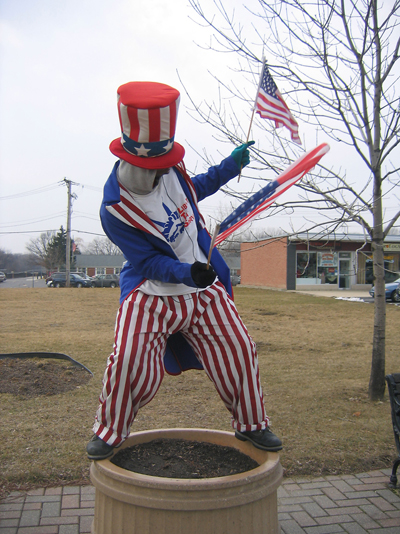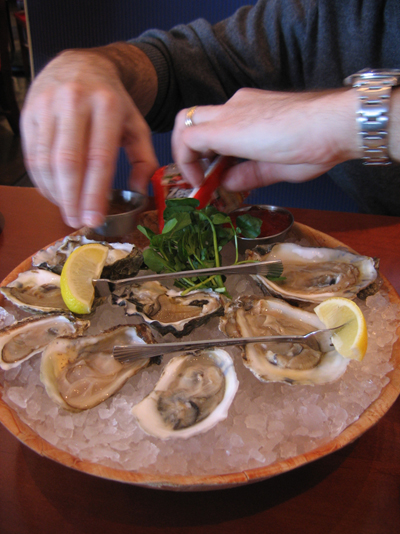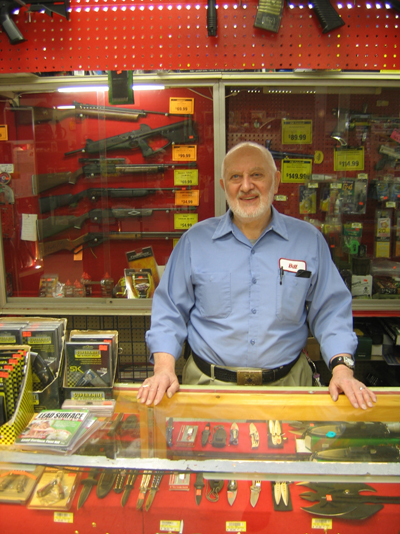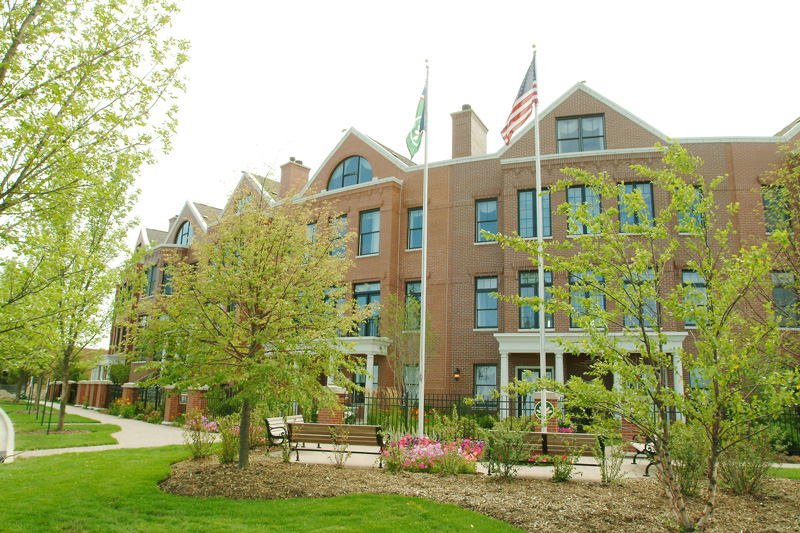I have put myself in a most unusual situation. First of all, it is the dead of winter and I am surrounded by nautical bric-a-brac – enough blue vinyl seating, polished brass and classic wooden boat models to call to mind the Adirondacks in July.
I am also in a restaurant, Mitchell’s Fish Market, which stands very close to the air traffic control tower of the former Glenview Naval Air Station. Gone are the military jets and saluting airmen; the 1,121-acre parcel is now home to handsome brick homes, winding streets, a large public park and a larger selection of shops than any other part of town. The former air base is now called The Glen, a mixed-use housing and retail community of mammoth proportions, and one that overshadows every other development in recent memory in this village 25 miles northwest of downtown Chicago.

It is noon and I am devouring a portion of Chilean Sea Bass, a Mitchell’s specialty. This is also an unusual trick – boasting this fish as a specialty – considering that we are a world away from the waters off Lima, Peru, where the fish was caught. Mitchell’s prints its menu twice daily so that only the freshest products are available. That, as the Mitchell’s philosophy goes, is better than having a freezer full of aging seafood.
“It’s okay to be out of something,” says Matt Borth, the restaurant’s general manager. “That tells people the fish we serve is fresh.”
Across the dining room there is a retail fresh seafood counter, open to diners on their way out, and to walk-ins picking up fresh fish to cook at home that night. So here I am in the middle of the country, in the middle of a refashioned military air base reminiscent of a yacht club, eating fresh fish in the middle of winter. And it’s working for me. It helps that the fish is done well and that it was a fresh piece of fish to start with, which again is all very unusual because restaurants like this didn’t exist in Glenview five years ago.
Back then, the dining options were severely limited. There were a few Chinese buffets, some fast food joints, the solid Johnny’s and the surprisingly good Grandpa’s, with its sublime tuna melt. There was Meier’s tavern for a burger and tater tots, and of course there was the venerable Hackney’s, with not one, but two restaurants in Glenview: one on Lake, and the original on Harms.

It is a different ballgame now. In addition to Mitchell’s, The Glen is home to Flight Restaurant and Wine Bar, the casual Red Star Tavern, Ted’s Montana Grill, the sushi restaurant Ra and the beer-centric Yard House, among others. For quicker bites there are places such as Gold Coast Dogs, Potbelly Sandwich Works and the Asian-themed Noodles & Company. There’s more. Anyone with a sweet tooth will love the fact that Ben & Jerry’s has opened a retail store in the commercial district of The Glen, “the Glen Town Center,” and so has the high-end Belgian chocolate maker Bernard Callebaut.
The progress doesn’t stop with food. A Von Maur department store anchors the retail district, which also is home to Ann Taylor Loft, and Jos. A. Bank stores. Spa and salon services call The Glen home, along with several other boutique stores and galleries, a 10-screen movie theater, and the Kohl Children’s Museum of Greater Chicago.
The Glen has two golf courses, a large park, a man-made lake, and bicycling and walking trails. That is the stuff for you, assuming you’re a visitor. For the people who live there (residents of The Glen make up about 10 percent of the village’s total population of 44,443), and for nearby neighbors in Glenview, there are other perks. These include two Metra stops, grocery stores, dry cleaning, a bank, a school, a church – just about everything you would expect to find in a suburb – all contained in this development and most of it within walking distance no matter which part of The Glen you’re in.
In essence, The Glen is a town within a town, with single-family homes, townhomes, senior housing, rental apartments and commercial office space.
“You have shopping, groceries, restaurants, movies, a new post office being built, and commercial office space,” says Jack Wexelberg, president of the Chicago division of Kimball Hill Homes. “It’s what I would call a homerun.”
Kimball Hill Homes is the developer of Tower Crossing, a group of 154 townhomes surrounding Glen Town Center in the middle of the larger Glen community. Pre-construction prices for Tower Crossing ran in the mid-$500s three years ago for homes in the 3,000- to 4,000-square-foot range. Now, the remaining unsold units – there are about a dozen in Tower Crossing – are listed in the mid-$700s.
“A lot of the established suburbs are either rejuvenating their downtowns or doing something like this,” Wexelberg says. “I think the fact that Glenview had the opportunity to do this allowed the village to reinvent itself and create an urban setting within a suburban community.”
That may sound a bit like the philosophy behind a theme park, but the consensus on The Glen is that although the project has caused some growing pains in Glenview, the new construction has been carried out with a tasteful aesthetic in mind. Sprawling across one and a half square miles and comprising about 15 percent of the total land mass in Glenview, The Glen’s development displaced 1 million cubic yards of concrete from the former air base. A mile and a half of runways were torn up, and 108 United States Navy buildings were razed. Then, in came the people.
Taxes went up. Two new fire stations had to be built. Lake Avenue was widened. And figuring out how to deal with new school costs might be an issue on an upcoming voting ballot.
“I would say, as with most changes in a community, it’s a mixed bag,” says Sandy Hausman, who has lived in Glenview since the early 1990s. About six years ago, she and her husband Dean Schott founded the Glenview Watch, a weekly Internet-based community news service that tracks, and sometimes challenges, the village’s governance.

Many Glenview residents were delighted when the new shops and parklands started opening in The Glen. To this day, you probably wouldn’t find many people who would complain directly about the new retail businesses. But considering that traffic already was an issue in the north and northwest suburbs, you will find plenty of residents who complain about increased congestion.
“When you add 4,000 people to a town in a short time, you’re going to see increased traffic jams,” Hausman says. “There’s no question that traffic problems have gotten worse in Glenview.”
Despite the fast and furious development, Hausman does not see Glenview as a drastically different place than it was when she first moved there. In many ways, the arrival of The Glen and its population have enriched the village, which was founded in 1899 and today is home to offices for several major corporations, such as Kraft Foods, Avon and Zenith.
Bill Hoffman and his wife raised four children in Glenview, in an old seven-room house just a few blocks from the village’s original downtown. The Hoffmans are only the third owners of their 114-year-old house, and have lived in Glenview for 35 years. Now retired, Bill Hoffman works five days a week, 8 a.m. to noon, at Bess Best Hardware, a Glenview institution that sells everything from baseball mitts and house paint to guns and live bait.
“Glenview has changed a lot,” Hoffman says, standing near an end-of-the-season display of snow blowers. “It’s not going to be the same quiet place it was. It’s not the town I raised my children in.”
The village of Glenview is bordered by the Edens Expressway on the east, Golf Road on the south; the Tri-State Tollway on the west, and Winnetka and Willow roads on the north. Glenview is west of Wilmette and north of Morton Grove, but also shares erratic borders with Skokie, Golf, Niles, Northbrook and Northfield. This explains the ironic name the village of Glenview originally enjoyed: “South Northfield.”
Glenbrook North and Glenbrook South are Glenview’s two public high schools, and both consistently rank among the top schools in the metropolitan area.
Housing stock varies from 1950s-style ranches on the west side of town to stately mansions on the east. The Glen, which sits more or less in the middle, could be thought of as the buffer zone between the older and newer sections of town even though, in reality, it is the newest.

“It has certainly brought a diverse and energetic new crowd to town,” Hauser says, adding that three of the village’s seven trustees live in The Glen. “I think there are a lot of nice things that have come about because of The Glen.”
Terry A. Max of G&A Realty in Glenview agrees.
“I think that Glenview before The Glen was more of a somewhat stagnant place,” he says. “Most of the homes in Glenview were older homes, and there wasn’t a lot of new construction.”
The Glenview real estate market consisted mostly of people shuffling houses. Families would outgrow one house and buy a larger one in another part of town. Empty nesters would downsize but remain in Glenview, where many of them have always lived.
“Glenview consisted largely of people who had lived here a very long time or were maybe even born here,” Max says. “Now, with the Glen, there are people coming in from other places – from Northbrook, from Skokie, and even some from Chicago.”
Through it all, downtown Glenview, with its Metra station (yes, there are a total of three train stations in Glenview) and shops has remained largely unchanged. There is speculation that it too might get a facelift someday in order to bring it up to speed with The Glen.
The Glen was a huge undertaking, though, and no one in town is likely to forget that the village served as master developer of the parcel – yet another unusual circumstance in this picture. The Glen has brought economic development to the community, but observers say, it also has proved more expensive in terms of public services than city officials guessed.
“Our public officials naively promised that this wouldn’t cost the taxpayers anything,” Hausman says. “I say ‘naively’ because I think they genuinely thought it wouldn’t cost us. I’m not complaining – it’s just that building public streets, sewers, parks and parking garages is expensive, and providing education and other services to new residents is costly. Because of that, our taxes have gone up. Glenview is discovering, to its dismay, that there really is no free lunch.”
This is true, but where lunch is concerned, just about anyone would agree that the $18.95 tab at Mitchell’s is reasonable for a pristine portion of Chilean sea bass steamed with ginger and scallions, and served with sticky rice and spinach in a rice wine soy sauce.
And frankly, if that is more than you like to spend at lunch, well, just think about all of those other new options. That’s worth something.
